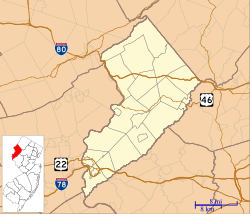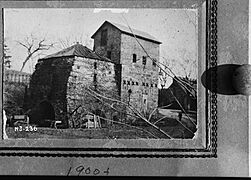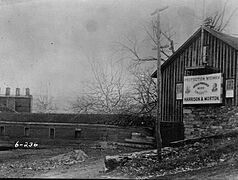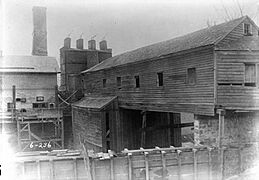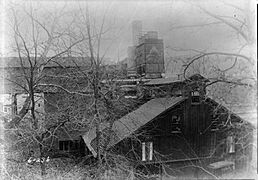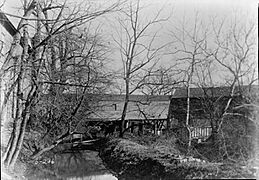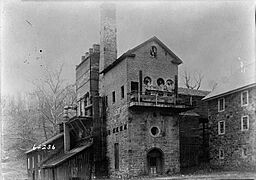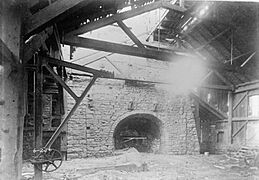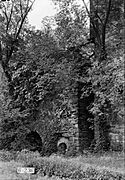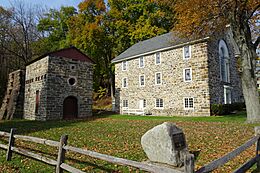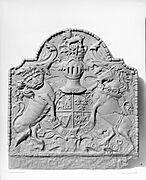Oxford Furnace facts for kids
|
Oxford Furnace
|
|
|
U.S. Historic district
Contributing property |
|

Oxford Furnace in 2015
|
|
| Location | Belvidere and Washington Avenues Oxford, New Jersey |
|---|---|
| Area | 0.6 acres (0.24 ha) |
| Part of | Oxford Industrial Historic District (ID91001471) |
| NRHP reference No. | 77000919 |
Quick facts for kids Significant dates |
|
| Added to NRHP | July 6, 1977 |
| Designated CP | August 27, 1992 |
The Oxford Furnace is a very old and important blast furnace located in Oxford, New Jersey. A blast furnace is a special kind of oven used to melt iron ore and turn it into metal. This furnace was built way back in 1741 by Jonathan Robeson. It started making its first metal, called pig iron, in 1743.
Oxford Furnace is famous for being the first place in the United States to successfully use a new method called "hot blast" technology in 1834. This new way of making iron helped factories produce much more metal. Because of its importance in history and industry, the furnace was added to the National Register of Historic Places in 1977. It's a great example of how things were made long ago!
Contents
The Story of Oxford Furnace
Building the Furnace
Oxford Furnace was the third charcoal furnace built in colonial New Jersey. It was special because it was the first one built right where iron ore was dug out of the ground. The first two furnaces in New Jersey used a different kind of iron ore found in swamps, called "bog iron."
Jonathan Robeson and Joseph Shippen, Jr., from Philadelphia, built the furnace around 1741. The Shippen family, who lived nearby, owned it. The furnace began making pig iron on March 9, 1743. Some of the first things made here were fireplace firebacks. These were metal plates for fireplaces, often decorated with the royal coat-of-arms of Great Britain.
From Grist Mill to Church
Next to the furnace, a grist mill was built in 1813. A grist mill is a place where grain is ground into flour. Many years later, around 1909 to 1915, this grist mill was changed into the Oxford Colonial Methodist Church.
New Ways to Make Iron
In 1834, a man named William Henry, who managed the furnace, made a big change. He was the first in the United States to successfully use "hot blast" technology. This meant blowing hot air into the furnace instead of cold air. This simple change made the furnace produce almost 10% more iron!
The next year, in 1835, William Henry made it even better. He put a hot blast oven right on top of the furnace. This made the air even hotter and increased iron production by almost 40%. This was a huge step forward for making metal.
The Scranton Family and Coal Power
In 1834, William Henry's assistant, Selden T. Scranton, took over the furnace. Selden later married William Henry's daughter, Jane. Selden's brother, George W. Scranton, also moved to Oxford in 1839 and married William Henry's other daughter.
The Scranton brothers bought the furnace business in 1840 and ran it together. Another brother, Charles, joined them in 1844. During this time, iron furnaces started using coal as fuel instead of wood and charcoal. The brothers also invested in railroads. Having access to anthracite coal from Pennsylvania and the nearby Morris Canal helped the Oxford Furnace keep running strong.
Challenges and Changes
The Oxford Iron Company was officially started in 1859 by George and Selden T. Scranton. During the American Civil War, the furnace was very busy, and the town of Oxford grew. In 1863, the furnace property was sold to the Oxford Iron Company.
In 1871, Selden and Charles Scranton, along with Eugene Henry, built a new furnace called Oxford Number 2. However, this new furnace was not as successful. This happened just as a big economic downturn, called the Panic of 1873, began. Selden faced many financial problems during these tough times.
The Furnace's Last Days
Oxford Furnace kept working longer than any other colonial furnace. It finally stopped operating in 1884. It became unusable because of a large crack in its inner wall.
Many of the people involved with the furnace passed away in the late 1800s. The Oxford Iron Company went bankrupt in 1889. The company was bought and reorganized several times. Furnace #2, the newer one, ran until 1921. By 1922, the only industry left in Oxford was mining, which had been happening in the area since before the furnace was built.
The State of New Jersey took ownership of both furnaces by 1935. Furnace #2 was taken down in the 1980s or 1990s. But the original Oxford Furnace still stands today, reminding us of its important past. The furnace was restored between 1997 and 2001, helping to preserve this piece of history.
Gallery
Notable People
- George M. Robeson (1829–1897) was a Union general during the Civil War. He later became the Secretary of the Navy under President Ulysses S. Grant.


